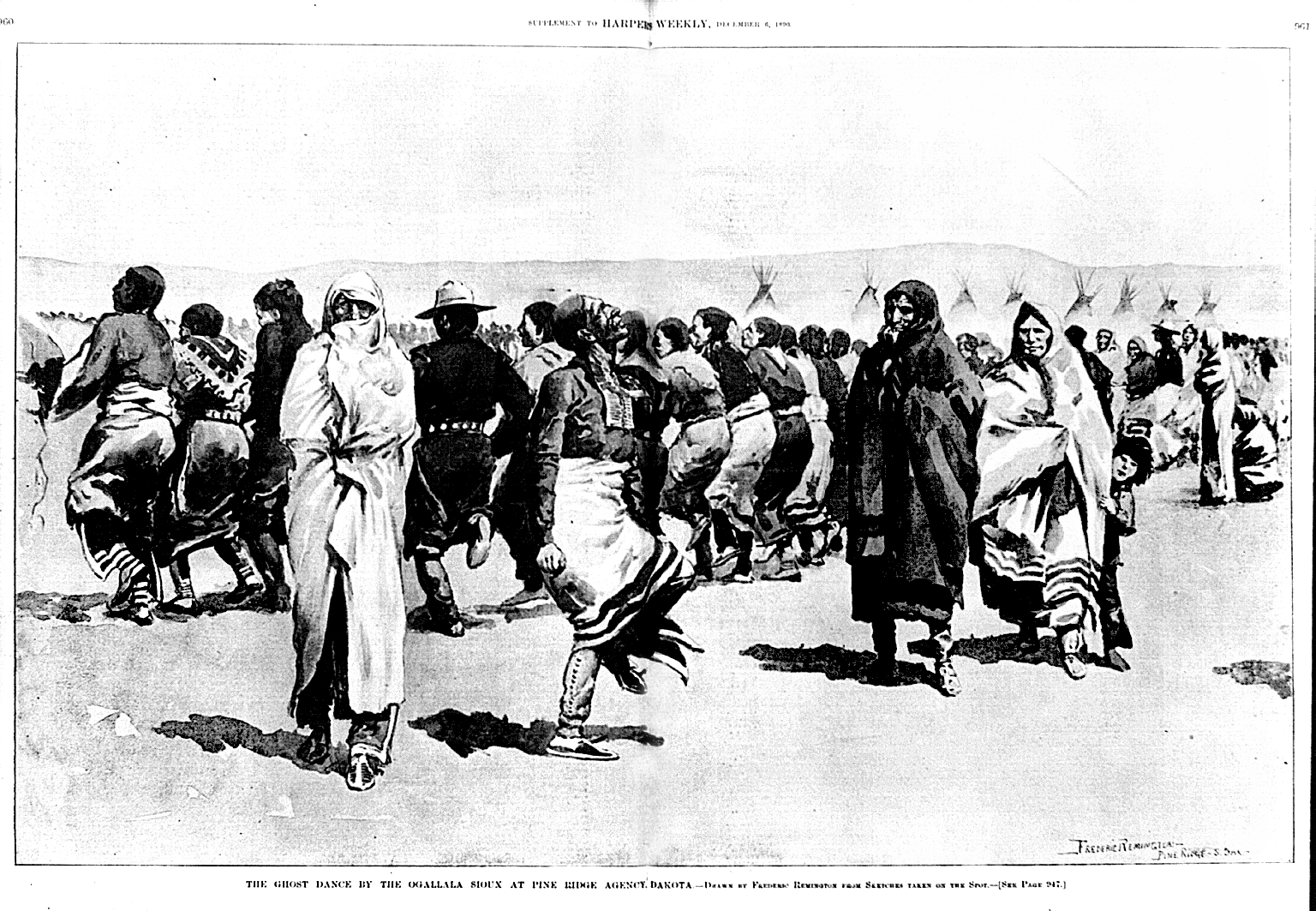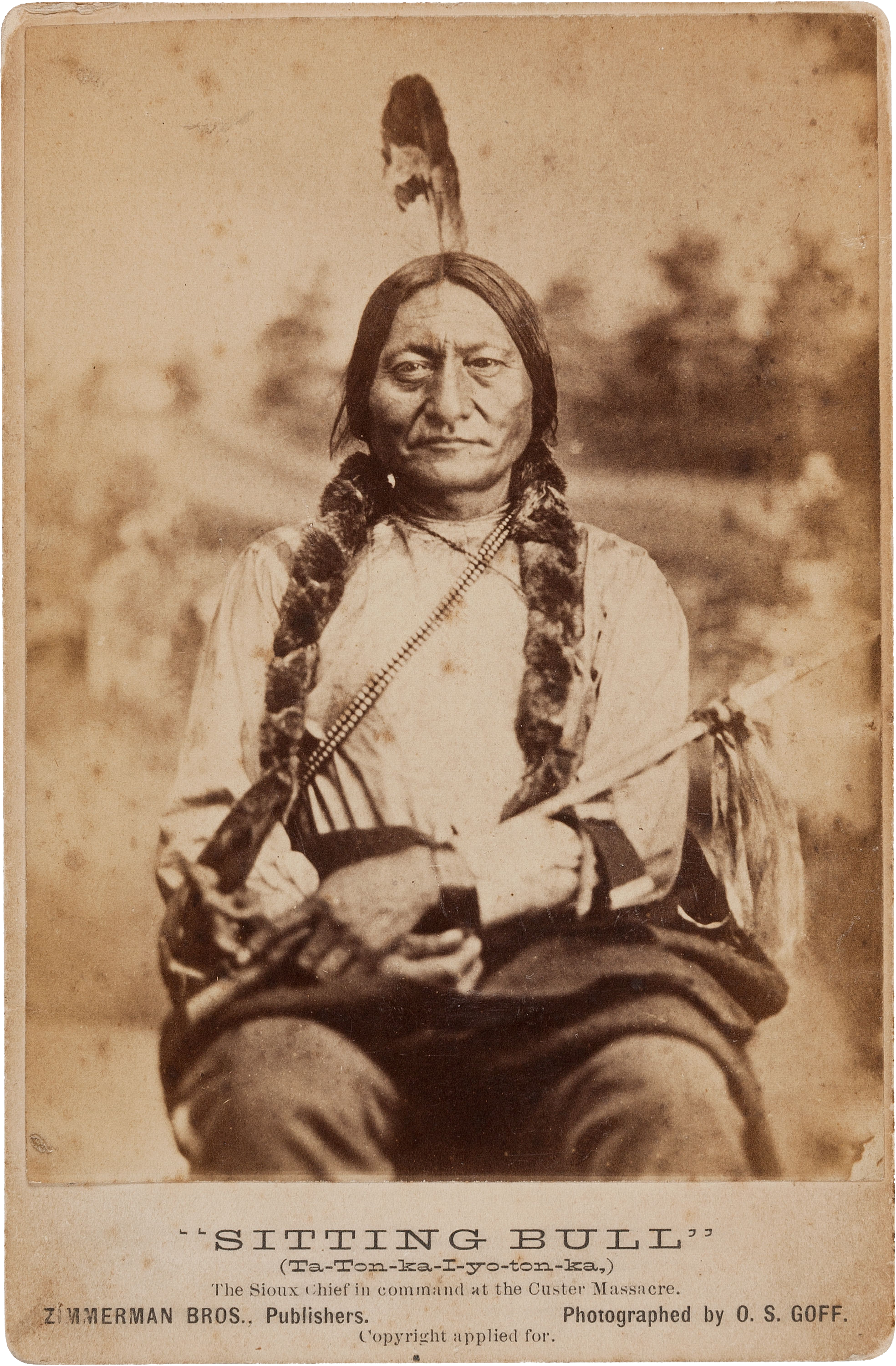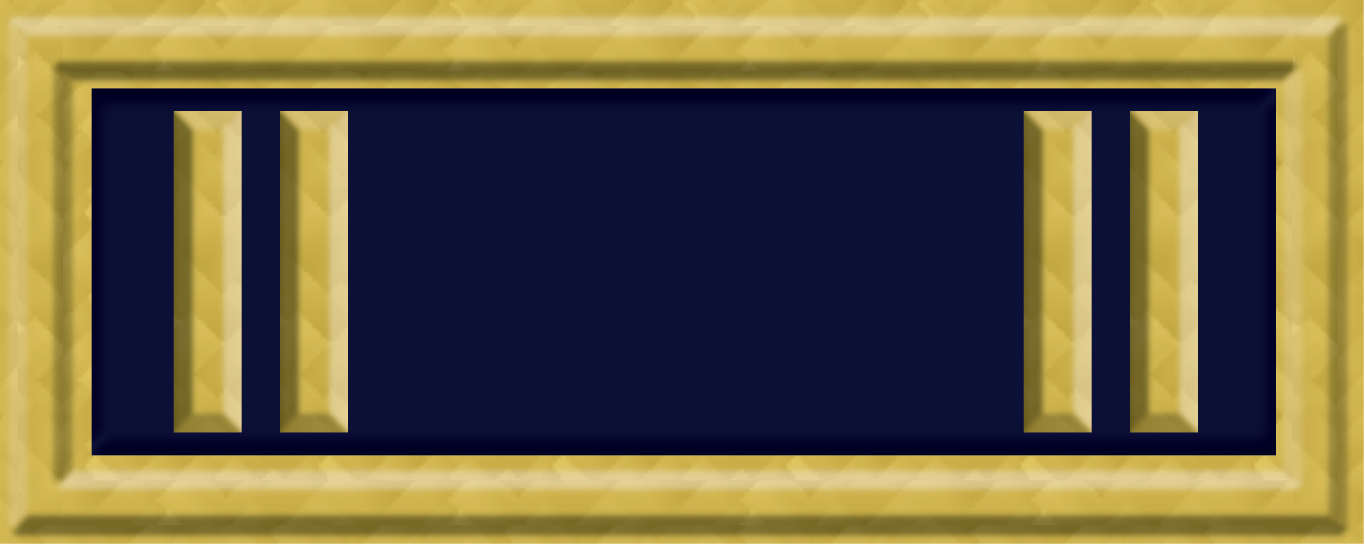|
Fort Yates, North Dakota
Yates is a city in Sioux County, North Dakota, United States. It is the tribal headquarters of the Standing Rock Sioux Tribe and county seat of Sioux County. Since 1970 the population has declined markedly from more than 1,100 residents, as people have left for other locations for work. The population was 176 at the 2020 census. History A primarily Native American settlement developed here after a US Army post at this site was established in 1863 as the Standing Rock Cantonment, intended for the US Army garrison to oversee the Hunkpapa and Blackfeet bands, and the Inhunktonwan and Cuthead of the Upper Yanktonai, of the Lakota Oyate. In 1878 the US Army renamed the fort to honor Captain George Yates, who was killed by the Lakota Oyate at the Battle of Little Big Horn in 1876. The town that developed was also known as Fort Yates. The Army post and fort were decommissioned in 1903. Fort Yates also served as the headquarters of the US Standing Rock Indian Agency, which in the la ... [...More Info...] [...Related Items...] OR: [Wikipedia] [Google] [Baidu] |
City
A city is a human settlement of notable size.Goodall, B. (1987) ''The Penguin Dictionary of Human Geography''. London: Penguin.Kuper, A. and Kuper, J., eds (1996) ''The Social Science Encyclopedia''. 2nd edition. London: Routledge. It can be defined as a permanent and densely settled place with administratively defined boundaries whose members work primarily on non-agricultural tasks. Cities generally have extensive systems for housing, transportation, sanitation, utilities, land use, production of goods, and communication. Their density facilitates interaction between people, government organisations and businesses, sometimes benefiting different parties in the process, such as improving efficiency of goods and service distribution. Historically, city-dwellers have been a small proportion of humanity overall, but following two centuries of unprecedented and rapid urbanization, more than half of the world population now lives in cities, which has had profound consequ ... [...More Info...] [...Related Items...] OR: [Wikipedia] [Google] [Baidu] |
Cantonment
A cantonment (, , or ) is a military quarters. In Bangladesh, India and other parts of South Asia, a ''cantonment'' refers to a permanent military station (a term from the colonial-era). In United States military parlance, a cantonment is, essentially, "a permanent residential section (i.e. barrack) of a fort or other military installation," such as Fort Hood. The word ''cantonment'', derived from the French word '' canton'', meaning ''corner'' or ''district'', refers to a temporary military or winter encampment. For example, at the start of the Waterloo campaign in 1815, while the Duke of Wellington's headquarters were in Brussels, most of his Anglo–allied army of 93,000 soldiers were ''cantoned'', or stationed, to the south of Brussels. List of permanent cantonments Afghanistan The former Sherpur Cantonment in Kabul, Afghanistan, which was the site of the Siege of the Sherpur Cantonment (1879) in the Second Anglo-Afghan War (1878–1880), is now maintained as a British Army ... [...More Info...] [...Related Items...] OR: [Wikipedia] [Google] [Baidu] |
Tribal College
In the United States, tribal colleges and universities (TCUs) are a category of higher education, minority-serving institutions defined in the Higher Education Act of 1965. Each qualifies for funding under the Tribally Controlled Colleges and Universities Assistance Act of 1978 (25 U.S.C. 1801 et seq.) or the Navajo Community College Act (25 U.S.C. 640a note); or is cited in section 532 of the Equity in Educational Land-Grant Status Act of 1994 (7 U.S.C. 301 note). These educational institutions are distinguished by being controlled and operated by federally recognized American Indian tribes; they have become part of American Indians' institution-building in order to pass on their own cultures. The first was founded by the Navajo Nation in 1968 in Arizona, and several others were established in the 1970s. As of 1994, they have been authorized by Congress as land-grant colleges.Ginger Stull, Demetrios Spyridakis, Marybeth Gasman, Andrés Castro Samayoa, & Yvette Booker, ''Redef ... [...More Info...] [...Related Items...] OR: [Wikipedia] [Google] [Baidu] |
Sitting Bull College
Sitting Bull College is a public tribal land-grant college in Fort Yates, North Dakota. It was founded in 1973 by the Standing Rock Sioux tribe of the Standing Rock Indian Reservation in south-central North Dakota. The SBC campuses are located in Fort Yates, North Dakota and McLaughlin, South Dakota. It serves as the primary educational institution on the Standing Rock Reservation.American Indian Higher Education Consortium History In 1973, the Standing Rock Sioux Tribal Council chartered Standing Rock Community College. The name was changed from Standing Rock College to Sitting Bull College in 1996. In 1994, the college was designated a land-grant colle ...[...More Info...] [...Related Items...] OR: [Wikipedia] [Google] [Baidu] |
Standing Rock Sioux Tribe
The Standing Rock Reservation ( lkt, Íŋyaŋ Woslál Háŋ) lies across the border between North and South Dakota in the United States, and is inhabited by ethnic " Hunkpapa and Sihasapa bands of Lakota Oyate and the Ihunktuwona and Pabaksa bands of the Dakota Oyate," as well as the Hunkpatina Dakota (Lower Yanktonai). The Ihanktonwana Dakota are the Upper Yanktonai, part of the collective of Wiciyena. The sixth-largest Native American reservation in land area in the US, Standing Rock includes all of Sioux County, North Dakota, and all of Corson County, South Dakota, plus slivers of northern Dewey and Ziebach counties in South Dakota, along their northern county lines at Highway 20. The reservation has a land area of , twice the size of the U.S. State of Delaware, and has a population of 8,217 as of the 2010 census. There are 15,568 enrolled members of the tribe. The largest communities on the reservation are Fort Yates, Cannon Ball (both located in Northern Stand ... [...More Info...] [...Related Items...] OR: [Wikipedia] [Google] [Baidu] |
Mobridge, South Dakota
Mobridge also Kȟowákataŋ Otȟúŋwahe ( Lakota: ''Kȟowákataŋ Otȟúŋwahe''; lit. "Over-the-River Town") is a city in Walworth County, South Dakota, United States. The population was 3,261 according to the 2020 census. History Located in territory that had long been occupied by the Lakota Sioux, Mobridge was founded by European Americans in 1906 following construction of the Chicago, Milwaukee, St. Paul and Pacific Railroad through here. The town was named Mobridge for its railroad designation, a contracted form of Missouri Bridge, after the original railroad bridge over the Missouri River. The bridge was demolished by the Corps of Engineers in the early 1960s and replaced by a higher bridge due to the construction of the Oahe Dam. There are disputed claims that some or all of chief Sitting Bull's remains were moved by his surviving relatives and the Dakota Memorial Association on April 8, 1953 from Fort Yates, North Dakota, where he had been killed and buried, to ... [...More Info...] [...Related Items...] OR: [Wikipedia] [Google] [Baidu] |
Ghost Dance
The Ghost Dance ( Caddo: Nanissáanah, also called the Ghost Dance of 1890) was a ceremony incorporated into numerous Native American belief systems. According to the teachings of the Northern Paiute spiritual leader Wovoka (renamed Jack Wilson), proper practice of the dance would reunite the living with spirits of the dead, bring the spirits to fight on their behalf, end American westward expansion, and bring peace, prosperity, and unity to Native American peoples throughout the region. The basis for the Ghost Dance is the circle dance, a traditional Native American dance. The Ghost Dance was first practiced by the Nevada Northern Paiute in 1889. The practice swept throughout much of the Western United States, quickly reaching areas of California and Oklahoma. As the Ghost Dance spread from its original source, different tribes synthesized selective aspects of the ritual with their own beliefs. The Ghost Dance was associated with Wovoka's prophecy of an end to colonial ... [...More Info...] [...Related Items...] OR: [Wikipedia] [Google] [Baidu] |
Sitting Bull
Sitting Bull ( lkt, Tȟatȟáŋka Íyotake ; December 15, 1890) was a Hunkpapa Lakota leader who led his people during years of resistance against United States government policies. He was killed by Indian agency police on the Standing Rock Indian Reservation during an attempt to arrest him, at a time when authorities feared that he would join the Ghost Dance movement. Before the Battle of the Little Bighorn, Sitting Bull had a vision in which he saw many soldiers, "as thick as grasshoppers", falling upside down into the Lakota camp, which his people took as a foreshadowing of a major victory in which many soldiers would be killed. About three weeks later, the confederated Lakota tribes with the Northern Cheyenne defeated the 7th Cavalry under Lt. Col. George Armstrong Custer on June 25, 1876, annihilating Custer's battalion and seeming to bear out Sitting Bull's prophetic vision. Sitting Bull's leadership inspired his people to a major victory. In response, the U.S. gov ... [...More Info...] [...Related Items...] OR: [Wikipedia] [Google] [Baidu] |
James McLaughlin (Indian Agent)
James McLaughlin (February 12, 1842 – July 28, 1923) was a Canadian-American United States Indian agent and inspector, best known for having ordered the arrest of Sitting Bull in December 1890, which resulted in the chief's death and contributed to the Wounded Knee Massacre. Before this event, he was known for his positive relations with several tribes. His memoir, published in 1910, was entitled, ''My Friend the Indian.'' McLaughlin emigrated to the United States at the age of 21, living briefly in St. Paul, Minnesota, where he married a Mdewakanton woman of mixed-blood descent. He soon became a citizen. While working as a blacksmith at Fort Totten, he studied to become a U.S. Indian agent, and was selected to supervise the Devils Lake Agency in 1876. He was promoted and transferred in 1881 to the larger Standing Rock Sioux Agency in the Dakotas, working there for many years, in an era of short-term political appointments. In 1895 he was promoted to a position as Inspecto ... [...More Info...] [...Related Items...] OR: [Wikipedia] [Google] [Baidu] |
Battle Of Little Big Horn
The Battle of the Little Bighorn, known to the Lakota and other Plains Indians as the Battle of the Greasy Grass, and also commonly referred to as Custer's Last Stand, was an armed engagement between combined forces of the Lakota Sioux, Northern Cheyenne, and Arapaho tribes and the 7th Cavalry Regiment of the United States Army. The battle, which resulted in the defeat of U.S. forces, was the most significant action of the Great Sioux War of 1876. It took place on June 25–26, 1876, along the Little Bighorn River in the Crow Indian Reservation in southeastern Montana Territory. Most battles in the Great Sioux War, including the Battle of the Little Bighorn (14 on the map to the right), "were on lands those Indians had taken from other tribes since 1851". The Lakotas were there without consent from the local Crow tribe, which had treaty on the area. Already in 1873, Crow chief Blackfoot had called for U.S. military actions against the Indian intruders. The steady Lakota in ... [...More Info...] [...Related Items...] OR: [Wikipedia] [Google] [Baidu] |
Sioux
The Sioux or Oceti Sakowin (; Dakota language, Dakota: Help:IPA, /otʃʰeːtʰi ʃakoːwĩ/) are groups of Native Americans in the United States, Native American tribes and First Nations in Canada, First Nations peoples in North America. The modern Sioux consist of two major divisions based on Siouan languages, language divisions: the Dakota people, Dakota and Lakota people, Lakota; collectively they are known as the Očhéthi Šakówiŋ ("Seven Council Fires"). The term "Sioux" is an exonym created from a French language, French transcription of the Ojibwe language, Ojibwe term "Nadouessioux", and can refer to any ethnic group within the Great Sioux Nation or to any of the nation's many language dialects. Before the 17th century, the Dakota people, Santee Dakota (; "Knife" also known as the Eastern Dakota) lived around Lake Superior with territories in present-day northern Minnesota and Wisconsin. They gathered wild rice, hunted woodland animals and used canoes to fish. Wars ... [...More Info...] [...Related Items...] OR: [Wikipedia] [Google] [Baidu] |
George Yates
George Wilhelmus Mancius Yates (February 26, 1843 – June 25, 1876) was an officer in the U.S. 7th Cavalry Regiment. He was killed in the Battle of the Little Bighorn. Biography Yates was born in Albany, New York. He met Custer in Monroe, Michigan, and they became close personal friends. During the American Civil War, Yates was a second lieutenant in the 4th Michigan Infantry. Custer helped him secure a position on General Alfred Pleasonton's staff. Yates earned several brevet promotions in rank for his actions during the war. He fought at the First Battle of Manassas, Antietam, Fredericksburg, and Gettysburg. After the Civil War, in 1866, Yates was appointed a captain in the 7th Cavalry. He served under Lt. Colonel Custer, commanding F Company. He was a member of the so-called "Custer Clan" or "Custer Gang" of close-knit friends and relatives of the General. Yates was killed during the Battle of the Little Bighorn and fell near Custer. According to some accounts, he is said ... [...More Info...] [...Related Items...] OR: [Wikipedia] [Google] [Baidu] |






.jpg)

